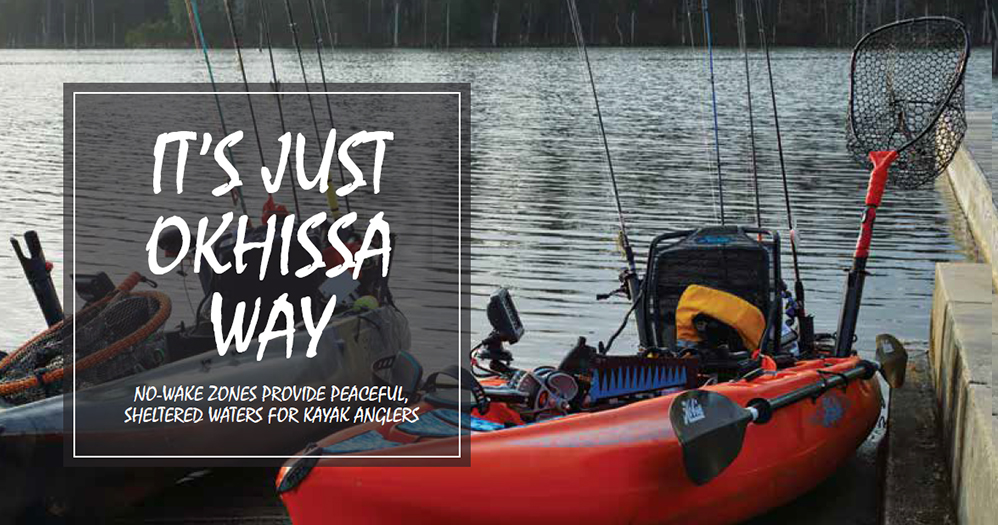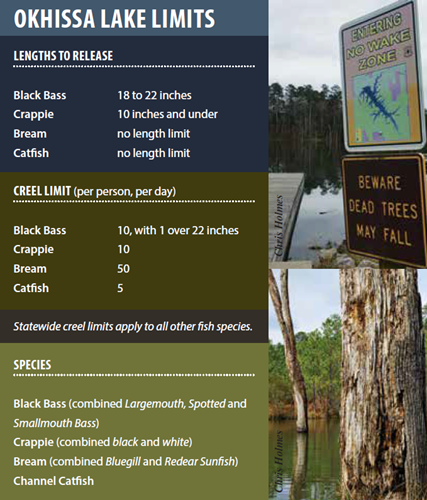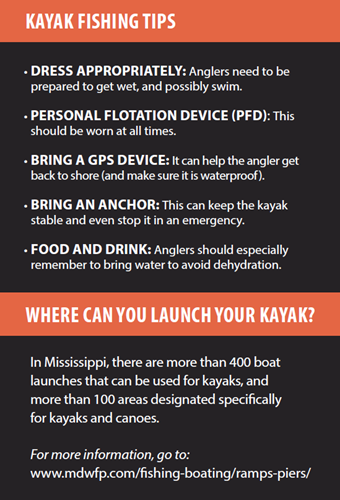It's Just Okhissa Way
8/16/2018 3:18:55 PM
By Chris Holmes

Kayak fishing in most popular bass lakes means keeping your head on a swivel and never getting to fully relax. Sparkly bass boats can zoom by, and a low-sitting kayak is at risk of being hit by the boat or getting swamped from the wake.
However, at Okhissa Lake, the majority of the lake is a no-wake zone that provides kayak anglers peace of mind combined with excellent bass fishing.
Nestled in the rolling hills of the Homochitto National Forest in Franklin County south of Bude, Okhissa has been open to the public for more than a decade. The lake boasts more than 1,000 surface acres and about 40 miles of shoreline. Stocked with bass, bream, crappie, and channel catfish, Okhissa provides prime fishing opportunities for a variety of freshwater species. Shad and minnows also were introduced to provide forage fish. However, being the first Bill Dance Signature Lake, the emphasis is on largemouth bass, the fish that made Dance famous. Many double-digit bass have been landed in Okhissa.
Thousands of acres of unspoiled wilderness surround this flooded timber impoundment, and currently, no camping or hunting is allowed in the area immediately surrounding the lake. Okhissa is a beautiful, scenic lake with steep, forested ridges. It is full of draws and drains that carve out small pockets and fingers with-in each of the various coves.
The main lake is narrow but relatively deep. At normal water levels, the lake reaches nearly 80 feet deep. The coves provide sheltered waters to kayak fish regardless of wind direction. Approximately two miles long from end to end, Okhissa can be traversed easily in a full day of kayak fishing. However, the many fingers and coves would take several trips to thoroughly fish and explore.
The lake has a self-service entrance with an honor box for cash payments ($5 per vehicle). There is no additional charge for launching. You receive a hangtag for your rear-view mirror as proof of payment. Launch areas are designated with roadside parking and launching prohibited.
Two doublewide, concrete boat ramps have textured surfaces for non-slip launching. The northern ramp accesses into the lake’s only skiing and boating area. Water skiing starts at 9 a.m.; personal watercraft are not allowed. The area offers excellent fishing opportunities, but kayak anglers who do not want to deal with dodging boats and wakes are advised to use the south ramp during the summer months.

The south ramp is about midway in the length of the lake and is recommended for kayak anglers new to Okhissa. Ample parking and a nice restroom facility are available. Launching there puts kayak anglers directly in the no-wake zone. These zones serve multiple purposes. While the flooded timber is a nice bass habitat, it presents a hazard for boats running at planning speeds. No boat lanes were created when the lake was filled, so it is virtually impossible to travel without hitting submerged trees. Additionally, the exposed trees, mostly pine, show signs of decay at and above the water line. Boat wakes can easily knock some of these trees over, presenting a danger to nearby anglers. Signs in the launch area warn boaters about the threat of falling trees.
Usually limited by their human-powered range, kayak anglers have learned a secret that bodes well for Okhissa: Fish do not know where the boat launch is. Steve Neece, a Hobie Kayak Fishing Team member from Louisiana, put the secret to the test on his first trip to Okhissa Lake.
Neece was fishing within mere yards of the south launch when he caught his first Okhissa bass within sight of the ramp. Throwing a deep diving crankbait, he bounced the lipped plastic offering in and out of the submerged timber in about 30 feet of water. Bass regulations at Okhissa allow anglers a 10-fish daily creel limit, with a slot of 18-22 inches. Fish within the slot range must be released, but anglers are allowed to keep one fish above 22 inches. This fish was a plump 14 inches and went on Neece’s stringer.
After missing a couple more bites, Neece focused on the lily pads and hydrilla mats that permeate Okhissa in the summer. He found fish holding near the lily pads, at the back of the cove. His technique of the day proved to be a red-and-white spinnerbait along the edges of the pads.
“I like using heavy braid line to haul these fish out of the lilies. The stems on these huge lily pads are tough as rope and 50–60 pound braid is necessary to get the fish through,” Neece said.

As summer wears on and the hydrilla and lily pads get thick, you should adapt your fishing methods and gear. The braided line helps cut through the vegetation and quickly horse fish through the heavy cover. When the fish are holding under the vegetation, top-water frogs worked across the large pads and hydrilla are a favored method to coax bass into a strike. Frog anglers must resist the instinct to set the hook immediately to ensure a positive hook-up. However, once hooked, it is an all-out battle to reel the fish up and out of the jungle as fast as possible. Punching through the thick hydrilla with heavy, weedless-rigged soft plastics and jigs is also a proven bass-catching tactic on Okhissa.
Because the steep banks created by filling the area did not provide many natural spawning sites, hundreds of spawning beds were built around the lake, on graded areas, covered with rocks. These areas are generally marked on maps. While primarily designed to aid in spawning, the differing relief and bottom material attract bass and other fish year-round.
Paddling the entire lake is not a problem, but those who use pedal-powered kayaks are cautioned about the submerged timber that exists throughout the lake. Deliberate, slow travel is advised to avoid damaging your drive system. Although the water is generally clear, these stumps seem to appear from nowhere and there is no give when you hit one. Slowly moving along allows you to safely pedal your kayak without risk of damage. If you want to work concentrated areas of standing timber, it is best to use your paddle.
The no-wake restrictions on Okhissa put kayak anglers on an even keel with all other vessels chasing bass around the lake. It is a fantastic lake for quietly exploring, and every cast offers the possibility of catching the bass of a lifetime.
Chris Holmes is a freelance writer for Mississippi Outdoors.









